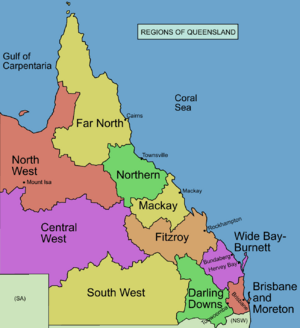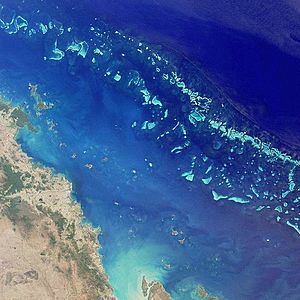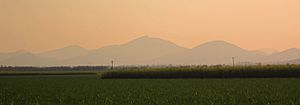Geography of Queensland facts for kids
Quick facts for kids Geography of Queensland |
|
|---|---|
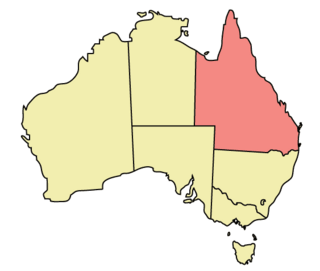 |
|
| Continent | Australia |
| Coordinates | 23°S 143°E / 23°S 143°E |
| Area | Ranked 2nd among states and territories |
| • Total | 1,729,742 km2 (667,857 sq mi) |
| Coastline | 6,973 km (4,333 mi) |
| Borders | Land borders: Northern Territory, New South Wales, South Australia |
| Highest point | Mount Bartle Frere 1,622 m (5,322 ft) |
| Longest river | Flinders River 840 km (521 mi) |
| Largest lake | Burdekin Dam 220 km² |
The geography of Queensland is super diverse! This big state in north-east Australia has everything. You can find sunny tropical islands, long sandy beaches, and flat plains that flood after big rains. There are also rugged mountains, dry deserts, rich farming areas, and busy cities.
Queensland covers a huge part of Australia, about 22.5% of the whole continent. It's the second largest state, covering 1,729,742 square kilometres. Imagine a coastline stretching for 6,973 kilometres on the mainland, plus another 6,374 kilometres around its islands! A super special part of Queensland's geography is the Great Barrier Reef, which is a huge draw for tourists. The Tropic of Capricorn line crosses through the state, meaning about half of Queensland is in the tropics.
Contents
What are Queensland's Borders?
Queensland shares its borders with three other parts of Australia. To the west, it borders the Northern Territory. This border follows a line of longitude (138th meridian east) until it meets the 26th parallel south at a spot called Poeppel Corner. This is where Queensland also meets South Australia.
The border then follows the 26th parallel south until it reaches the 141st meridian east at Haddon Corner. From there, it turns south to Cameron Corner, which is on the 29th parallel south. This spot is the most western point of Queensland's border with New South Wales.
The border with New South Wales then follows the 29th parallel south towards the coast. It also follows several rivers like the Macintyre River, Severn River, and Weir River. These rivers are all part of the Barwon River system. Finally, the border crosses some mountain ranges until it reaches Point Danger on the coast.
Exploring Queensland's Regions
Queensland is so big that it's divided into several unofficial areas called regions. People use these names to talk about different parts of the state. Here are some of the main ones:
- South East Queensland: This is the busiest part, located in the state's bottom-right corner. It's home to Queensland's three biggest cities: Brisbane (the capital), the Gold Coast, and the Sunshine Coast. More than 70% of Queensland's people live here!
- The Darling Downs: Found inland from South East Queensland, this area has very fertile land. It's great for farming, especially for raising cattle. This region also includes the Granite Belt, which is Queensland's coldest area and sometimes even sees snow!
- Wide Bay–Burnett: This coastal region is north of South East Queensland. It's famous for its sugar cane farms. Cities like Bundaberg and Hervey Bay are here, along with Fraser Island, the world's largest sand island.
- Central Queensland: Located on the state's central coast, this region is known for cattle farms and coal mining. It includes popular tourist spots like the Capricorn Coast and Whitsunday Islands, plus the cities of Rockhampton and Mackay.
- North Queensland: On the northern coast, this area also has lots of cattle farms and mining. The city of Townsville is located here.
- Far North Queensland: This is the very top part of Queensland, stretching along the Cape York Peninsula. It has amazing tropical rainforests, Queensland's highest mountain (Mount Bartle Frere), and the Atherton Tablelands where they grow sugar cane and tropical fruits. It's also where you'll find the most visited part of the Great Barrier Reef and the city of Cairns.
- South West Queensland: This inland region in the state's south-west is mainly for farming cattle. It includes the Channel Country, where rivers split into many small streams.
- Central West Queensland: In the middle of the state, this inland area is also dominated by cattle farming. The city of Longreach is here.
- North West Queensland: This region is in the inland north-west, along the Gulf of Carpentaria. It's mostly savanna (grasslands) and known for mining. The city of Mount Isa is in this area.
Queensland's Natural Features
Islands of Queensland

Queensland has many islands, some of them very famous! Fraser Island is the biggest sand island in the world. It has unique "perched lakes" or "dune lakes" – these rare lakes form in hollows between sand dunes and have no rivers flowing in or out. There are 80 of these lakes on Fraser Island, which is half of all such lakes worldwide!
Other islands like Magnetic Island, Heron Island, Great Keppel Island, Hamilton Island, and the Whitsunday Islands are popular for tourist resorts. Mornington Island and Great Palm Island are home to large Aboriginal communities. In the Torres Strait, Thursday Island is an important centre for the Torres Strait Islands.
Hinchinbrook Island, a big, mountainous island near Cardwell, is completely protected as a national park. North West Island is a coral island that is a vital nesting place for sea birds and turtles.
Closer to Brisbane, in the south-east, are Bribie, Moreton, North Stradbroke, and South Stradbroke islands. North Stradbroke Island is the second largest sand island in the world. Bribie Island is the most developed because it's connected to the mainland by a bridge.
Waterways and Coasts

To Queensland's north-west is the Gulf of Carpentaria. North of the Cape York Peninsula is Torres Strait, filled with many Torres Strait Islands. The most northern of these is Boigu Island. To the east of Queensland is the Coral Sea, which is part of the Pacific Ocean.
Along the coast, you'll find major bays like Princess Charlotte Bay, Shoalwater Bay (north of Yeppoon), Hervey Bay (between Fraser Island and the mainland), Trinity Bay (near Cairns), and Moreton Bay (near Brisbane). The Great Sandy Strait is a passage that runs south of Hervey Bay, between the mainland and Fraser Island.
The beaches on the Gold Coast and Sunshine Coast are long and sandy, attracting many tourists and surfers. Further north, the waves are calmer because of the Great Barrier Reef.
Queensland's biggest dam is the Burdekin Dam, followed by Lake Awoonga. The state doesn't have many large natural lakes. There are a few small natural lakes formed by old volcanoes and coastal lagoons, mostly in South East Queensland. Lakes in the dry parts of Queensland often have very little rain and high evaporation, so they can be quite dry.
Rivers and Waterfalls
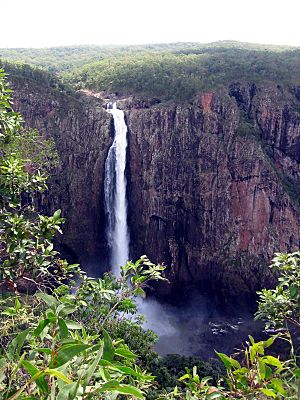
Queensland has hundreds of rivers and even more smaller creeks. The water flowing from these rivers, especially in the tropical north, makes up 45% of all the surface water runoff in Australia!
Important coastal rivers include the Mitchell River, Fitzroy River, Mary River, and Brisbane River. The Flinders River is the longest at 840 kilometres. Inland, you'll find rivers that flow into the Murray River system, such as the Maranoa River, Warrego River, and Condamine River. Rivers of the Lake Eyre Basin include Cooper Creek (with its main branches, the Thomson River and Barcoo River) and the Georgina River. The Wenlock River has more types of freshwater fish than any other river in Australia.
Barron Falls in the north is one of Queensland's most amazing waterfalls. When it rains a lot, the area turns into a powerful, gushing torrent! Similarly, Purlingbrook Falls in the Gold Coast Hinterland looks incredible after heavy rain. Wallaman Falls, west of Ingham in North Queensland, is Australia's tallest single-drop waterfall. Other cool waterfalls include Milla Milla Falls and Coomera Falls.
Some towns in Queensland are built on flat land next to rivers. This means that during big floods, like the 2010 Queensland floods, many towns can get covered in water. Walls called levees help with smaller floods, but after long periods of heavy rain, there's just too much water to hold back. Flooding has become a normal part of life in inland towns like Charleville and sometimes in coastal towns like Gympie.
Mountains and Ranges
Eastern Queensland has the large Great Dividing Range, which is very different from the flat western areas. East of this range is a narrow coastal strip. Most of Queensland's people live here. This strip also has fertile soil and a moist climate, making it perfect for growing sugar cane, which is a very important crop for the state.
Other high areas include parts of the Barkly Tableland, the Atherton Tablelands, and the Central Highlands, which contain Carnarvon Gorge. The Granite Belt is Queensland's main region for making wine. The Bunya Mountains are a beautiful, isolated part of the Great Dividing Range. They are important for wildlife in an area where much land has been cleared. Closer to the coast are the Glasshouse Mountains, which are old volcanic plugs named by explorer Captain James Cook. Another natural wonder is the group of mountains in South East Queensland known as the Scenic Rim.
The highest mountains in Queensland are Mount Bartle Frere (1,622 metres), Mount Bellenden Ker (1,593 metres), Mount Superbus (1,375 metres), Mount Barney (1,359 metres), and Thornton Peak (1,374 metres).
Queensland's Climate Zones
Because Queensland is so big, its weather changes a lot from one area to another. Along the coast, there's plenty of rain. The tropical north has a wet season with monsoon rains, while the southern coast has a humid sub-tropical climate. Inland and in the west, it's usually dry with hot, humid summers. In the higher areas of the south-east inland, winter temperatures can drop below freezing, bringing frost and, rarely, snowfall. The warm ocean waters near the coast help keep temperatures steady and provide moisture for rain.
Queensland has six main climate zones, based on temperature and how humid it is:
- Hot and humid summer, warm and humid winter (far north and coast): Like Cairns and Innisfail.
- Hot and humid summer, warm and dry winter (north and coast): Like Townsville and Mackay.
- Hot and humid summer, mild and dry winter (coastal high areas and south-east coast): Like Brisbane, Bundaberg, and Rockhampton.
- Hot and dry summer, mild and dry winter (central inland and north-west): Like Mt Isa, Emerald, and Longreach.
- Hot and dry summer, cool and dry winter (southern inland): Like Roma, Charleville, and Goondiwindi.
- Warm and humid summer, cold and dry winter (elevated south-eastern areas): Like Toowoomba, Warwick, and Stanthorpe.
Here's a quick look at the average weather for some Queensland cities:
| City | Min. temp | Max. temp | No. clear days | Rainfall |
|---|---|---|---|---|
| Brisbane | 15.7 °C (60.3 °F) | 25.5 °C (77.9 °F) | 113.1 | 1,149.1 mm (45.24 in) |
| Mackay | 19.0 °C (66.2 °F) | 26.4 °C (79.5 °F) | 123.0 | 1,570.7 mm (61.84 in) |
| Cairns | 21.0 °C (69.8 °F) | 29.2 °C (84.6 °F) | 89.7 | 1,982.2 mm (78.04 in) |
| Townsville | 19.8 °C (67.6 °F) | 28.9 °C (84.0 °F) | 120.9 | 1,136.7 mm (44.75 in) |
The far north coast of Queensland is the wettest part of Australia. Mount Bellenden Ker, south of Cairns, holds many Australian rainfall records, with an average of over 8 metres of rain each year! Snow is rare in Queensland, but it does fall sometimes along the southern border with New South Wales, especially in the Stanthorpe area. Very rarely, snow has been seen further north.
Queensland can face natural disasters. Strong tropical cyclones can hit the central and northern coasts, causing a lot of damage. Recent examples include Cyclones Larry, Yasi, Ita, and Debbie. Heavy rain can also cause severe flooding anywhere in Queensland. One of the most damaging floods happened in early 2011. Strong thunderstorms often affect the south-east and inland areas, bringing powerful winds, heavy rain, large hail, and even tornadoes. The strongest tornado ever recorded in Australia happened in Queensland near Bundaberg. Droughts and bushfires can also happen, though bushfires are usually not as bad as in southern states.
The highest temperature ever officially recorded in Queensland was 49.5°C at Birdsville Police Station on December 24, 1972. Queensland has the highest average maximum temperatures of any Australian state. Only a few large towns like Stanthorpe, Hervey Bay, Mackay, Atherton, Weipa, and Thursday Island have never recorded a temperature above 40°C. The lowest temperature ever recorded was -10.6°C at Stanthorpe on June 23, 1961, and at The Hermitage (near Warwick) on July 12, 1965. However, temperatures below 0°C are generally not common in most populated parts of Queensland.
| Climate data for Queensland | |||||||||||||
|---|---|---|---|---|---|---|---|---|---|---|---|---|---|
| Month | Jan | Feb | Mar | Apr | May | Jun | Jul | Aug | Sep | Oct | Nov | Dec | Year |
| Record high °C (°F) | 49.0 (120.2) |
47.2 (117.0) |
46.7 (116.1) |
41.7 (107.1) |
39.3 (102.7) |
36.0 (96.8) |
36.1 (97.0) |
38.5 (101.3) |
42.4 (108.3) |
45.1 (113.2) |
48.7 (119.7) |
49.5 (121.1) |
49.5 (121.1) |
| Record low °C (°F) | 5.4 (41.7) |
3.3 (37.9) |
−0.2 (31.6) |
−3.5 (25.7) |
−6.8 (19.8) |
−10.6 (12.9) |
−10.6 (12.9) |
−9.4 (15.1) |
−5.6 (21.9) |
−3.6 (25.5) |
0.0 (32.0) |
2.2 (36.0) |
−10.6 (12.9) |
| Source 1: Bureau of Meteorology | |||||||||||||
| Source 2: Bureau of Meteorology | |||||||||||||
| Climate data for Brisbane (Köppen Cwa/Cfa) | |||||||||||||
|---|---|---|---|---|---|---|---|---|---|---|---|---|---|
| Month | Jan | Feb | Mar | Apr | May | Jun | Jul | Aug | Sep | Oct | Nov | Dec | Year |
| Record high °C (°F) | 40.0 (104.0) |
41.7 (107.1) |
37.9 (100.2) |
33.7 (92.7) |
30.7 (87.3) |
29.0 (84.2) |
29.1 (84.4) |
35.4 (95.7) |
37.0 (98.6) |
38.7 (101.7) |
38.9 (102.0) |
41.2 (106.2) |
41.7 (107.1) |
| Mean daily maximum °C (°F) | 30.4 (86.7) |
30.1 (86.2) |
29.1 (84.4) |
27.2 (81.0) |
24.5 (76.1) |
22.0 (71.6) |
22.0 (71.6) |
23.4 (74.1) |
25.7 (78.3) |
27.1 (80.8) |
28.3 (82.9) |
29.6 (85.3) |
26.6 (79.9) |
| Daily mean °C (°F) | 26.1 (79.0) |
25.8 (78.4) |
24.7 (76.5) |
22.2 (72.0) |
19.2 (66.6) |
16.9 (62.4) |
16.2 (61.2) |
17.1 (62.8) |
19.7 (67.5) |
21.7 (71.1) |
23.5 (74.3) |
25.0 (77.0) |
20.7 (69.3) |
| Mean daily minimum °C (°F) | 21.6 (70.9) |
21.4 (70.5) |
20.2 (68.4) |
17.4 (63.3) |
13.8 (56.8) |
11.9 (53.4) |
10.4 (50.7) |
10.9 (51.6) |
13.9 (57.0) |
16.5 (61.7) |
18.8 (65.8) |
20.5 (68.9) |
16.4 (61.5) |
| Record low °C (°F) | 17.0 (62.6) |
16.5 (61.7) |
12.2 (54.0) |
10.0 (50.0) |
5.0 (41.0) |
5.0 (41.0) |
2.6 (36.7) |
4.1 (39.4) |
7.0 (44.6) |
8.8 (47.8) |
10.8 (51.4) |
14.0 (57.2) |
2.6 (36.7) |
| Average precipitation mm (inches) | 138.1 (5.44) |
185.2 (7.29) |
131.6 (5.18) |
61.3 (2.41) |
61.1 (2.41) |
63.8 (2.51) |
27.5 (1.08) |
34.2 (1.35) |
26.6 (1.05) |
86.3 (3.40) |
95.7 (3.77) |
129.1 (5.08) |
1,011.5 (39.82) |
| Average rainy days (≥ 1 mm) | 8.2 | 10 | 9.7 | 7 | 5.6 | 6.6 | 3.8 | 3.5 | 3.6 | 7.1 | 7.6 | 8.9 | 81.6 |
| Average afternoon relative humidity (%) | 57 | 59 | 57 | 54 | 49 | 52 | 44 | 43 | 48 | 51 | 56 | 57 | 52 |
| Mean monthly sunshine hours | 267 | 235 | 233 | 237 | 239 | 198 | 239 | 270 | 267 | 270 | 273 | 264 | 2,989 |
| Source: Bureau of Meteorology | |||||||||||||
Cities and Towns in Queensland
Brisbane is the capital city of Queensland. It's located in the most populated area, South East Queensland. Other big cities in this region include the Gold Coast, Ipswich, Logan, and Redcliffe City. Toowoomba, the second largest inland city in Australia, is about 120 km west of Brisbane in the Darling Downs. Warwick is also nearby.
Townsville is the biggest city in the state's north. Other northern cities include Mount Isa, which is a mining town, Charters Towers, and Cairns. Mackay is also in the north; it's Australia's biggest exporter of sugar and a major coal exporter.
In the central parts of Queensland, you'll find cities like Rockhampton, Bundaberg, Gladstone (with its important coal exporting port), Maryborough, and Hervey Bay. The largest ports in Queensland are the Port of Gladstone, then the Port of Brisbane, and finally the Port of Townsville.
Some towns and settlements in Queensland are known as Aboriginal communities, such as Palm Island and Cherbourg.
How People Get Around: Transport
Queensland has train lines that run along the eastern coast, from the Gold Coast all the way to Kuranda. Major train lines also go inland to places like Longreach, Charleville, and Mount Isa.
For roads, the Pacific Highway connects Brisbane and Sydney along the coast. The New England Highway links these cities inland. The Newell Highway connects Goondiwindi to the southern states through central New South Wales. The Bruce Highway travels along the coast from Brisbane to Townsville. Some parts of it near Gympie were once described as some of the worst national highway sections in Australia.
Protected Natural Areas
Queensland has many important rainforests and other areas with lots of different plants and animals. Some of these are so special they are listed as World Heritage Areas. These include the amazing Great Barrier Reef, the Wet Tropics of Queensland (which are ancient rainforests), and parts of the Gondwana Rainforests of Australia.
Queensland has 226 national parks! The biggest one is Simpson Desert National Park in the remote central west of the state. In South East Queensland, the most visited national parks are Tamborine National Park, Lamington National Park, and Noosa National Park. These parks are easy to get to from major cities. Lamington and other parks around the Scenic Rim, like Main Range National Park, are part of the World Heritage listed Gondwana Rainforests.
Further away, you can visit Carnarvon National Park in Central Queensland. It has rugged gorge country and some of Australia's best Aboriginal rock art. In the north, there's Boodjamulla National Park (which includes Riversleigh, famous for its fossils), Barron Gorge National Park, and Daintree National Park. The Daintree is special because the Wet Tropics rainforest meets the Great Barrier Reef there.
Some waterways are also protected in three state marine parks: the Great Barrier Reef Marine Park, Great Sandy Marine Park, and Moreton Bay Marine Park.
See also
 In Spanish: Geografía de Queensland para niños
In Spanish: Geografía de Queensland para niños


